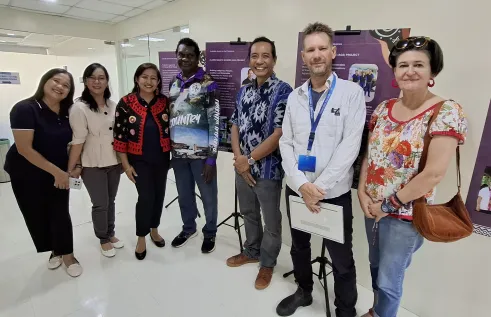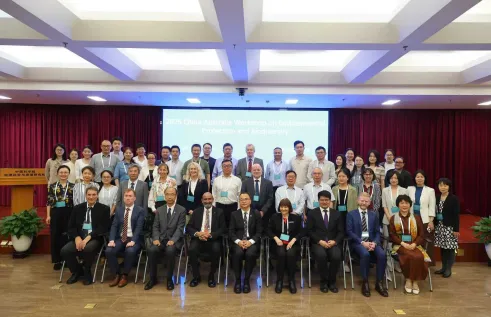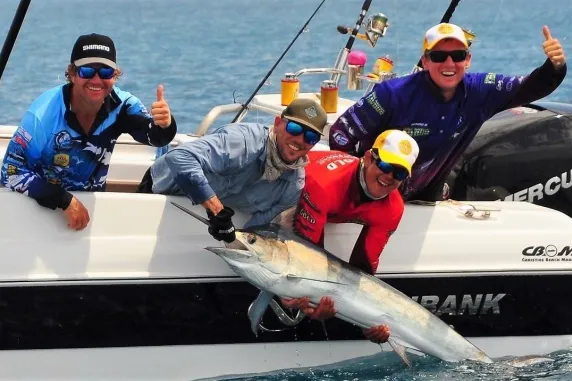RIEL news
Tracking the world’s fastest fish – new CDU research and PhD project
One of the world’s most iconic and sought-after sports fish will be the subject of a new research project at Charles Darwin University led by Dr. Keller Kopf, Prof. Hamish Campbell and PhD candidate Matt Hammond. The project is a collaboration with citizen scientist recreational fishers, the Department of Industry Tourism and Trade, the Australian Institute of Marine Science (AIMS), the Amateur Fishermen’s Association of the Northern Territory (AFANT) and fisheries ecologists.
The group of saltwater predatory fishes known as Billfish are famous for their sword-like facial protuberances as well as their impressive speed and size. Billfish boast one of the fastest fish in the ocean, the Sailfish, whilst the Black Marlin can reach up to 700kg. Across the Top End of Australia, where fishing is so often considered much more than just a pastime, these characteristics make billfish coveted trophies. The trophy is most-often just a photo - almost all recreational billfishing is catch-and-release, which means there is potential scope to develop sustainable fisheries tourism in the Top End.
Despite their popularity amongst the fishing community, we don’t know a great deal about the movement and ecology of billfish in Northern Australia. It is this lack of knowledge that has proven the impetus for the Fisheries Research and Development Corporation funded project and Matthew Hammond’s freshly started PhD project. He aims to learn a lot more about how billfish move, and, in turn, why Northern Australia seems so abnormally productive for certain billfish. “There’s juvenile billfish in these waters all year long, and that’s really unique. With some luck, we are hoping we can track up to 25 fish to see where they are going and what they’re getting up to.”
Matt has his work cut out for him. As he says, he wants to attach 25 tags to 25 billfish, and that means getting 25 of the ocean’s most powerful fish on the end of a line and back to the boat. Unfortunately for Matt, another reason that billfish are so coveted as trophies is that they are notoriously difficult to catch. So difficult in fact that when fishers target billfish, it’s considered an achievement just to get a marlin or a sailfish to take an interest in your bait (known as ‘raising’ a fish). Luckily, Matt has a small, fishing-obsessed tropical city from which to find volunteers to help him land the fish – he plans to utilise the help of local fisho knowledge to attach the tags.
On top of learning more about billfish movement and ecology, Matt hopes to learn more about how the tags work and the effect they have on the fish. Matt will trial two types of tags, acoustic and satellite. The acoustic tags emit a signal which needs to be picked up by stationary buoys that are deployed in common billfish hotspots - and are therefore dependant on the fish swimming close to those buoys. This type of tag needs to be surgically inserted into the fish’s abdomen, which Matt says can be a somewhat invasive means of gathering data, but have good longevity. “The tags can last up to ten years, so should provide some quality data on the effect of the catch, surgery, and release upon the target fish.”
Matt will also be using satellite tags, which he says are much less invasive to install but only last about 3 to 12 months. “Our satellite tags don’t actually require us to get the fish on board the boat, we just need to bring the fish up alongside and we can insert the tag into the muscle tissue.” These tags store data on the fishes location, depth and movement. After 6 to 12 months the tags automatically release and float to the surface where they transmit that data to a satellite.
The new research will inform decision-making for the recreational billfish fishery which is an important economic driver (through tourism) in multiple rural centres across Northern Australia. The data collected will add to the global knowledge on this group of highly migratory predators, of which some species are considered vulnerable. The team will start the tracking process in April 2022, so watch this space.
The emerging billfish fishing grounds of northern Australia: fisheries description, movements, and hot-spots is supported by funding from the FRDC on behalf of the Australian Government, and by the Northern Territory Recreational Fishing Grants Scheme.
R. Keller Kopf; M. Hammond; H. Campbell; V. Udyawer; K. Dysart; M. Grubert; D. Ciaravolo; S. Williams; D. Crook; S. Tracey; R. Buckworth; and J. Pepperell. (2022-2025). The emerging billfish fishing grounds of northern Australia: fisheries description, movements, and hot-spots. Fisheries Research and Development Corporation. Project Number 2021-001.
Related Articles

Environmental researchers and rangers visit Philippines as part of NT-Philippines exchange
CDU researchers and representative from Dhimurru Aboriginal Corporation completed a valuable exchange with Philippine leaders and rangers in June 2025.
Read more about Environmental researchers and rangers visit Philippines as part of NT-Philippines exchange
Professorial delegation discusses environmental protection and biodiversity in Beijing
Charles Darwin University (CDU) academics were among a high-level Australian delegation that visited the Chinese Academy of Sciences (CAS) last month.
Read more about Professorial delegation discusses environmental protection and biodiversity in Beijing
Rangers and PhD candidate unite at mapping workshop
How can technology support the revival of knowledge, its intergenerational transmission, and the defense of ancestral lands, all while ensuring cultural protocols are upheld?
Read more about Rangers and PhD candidate unite at mapping workshop
